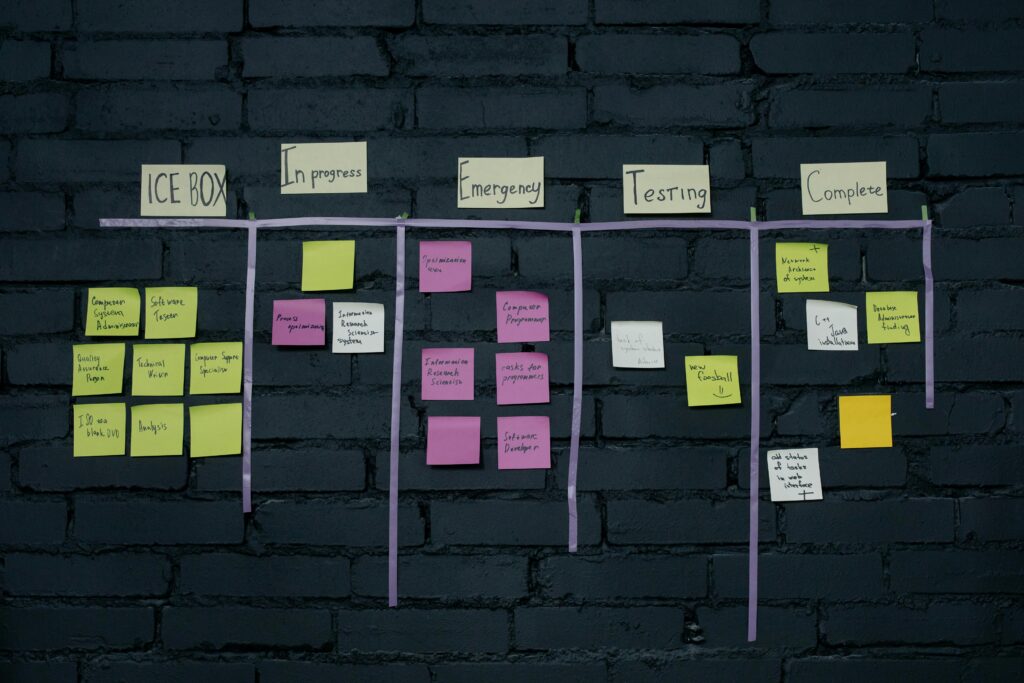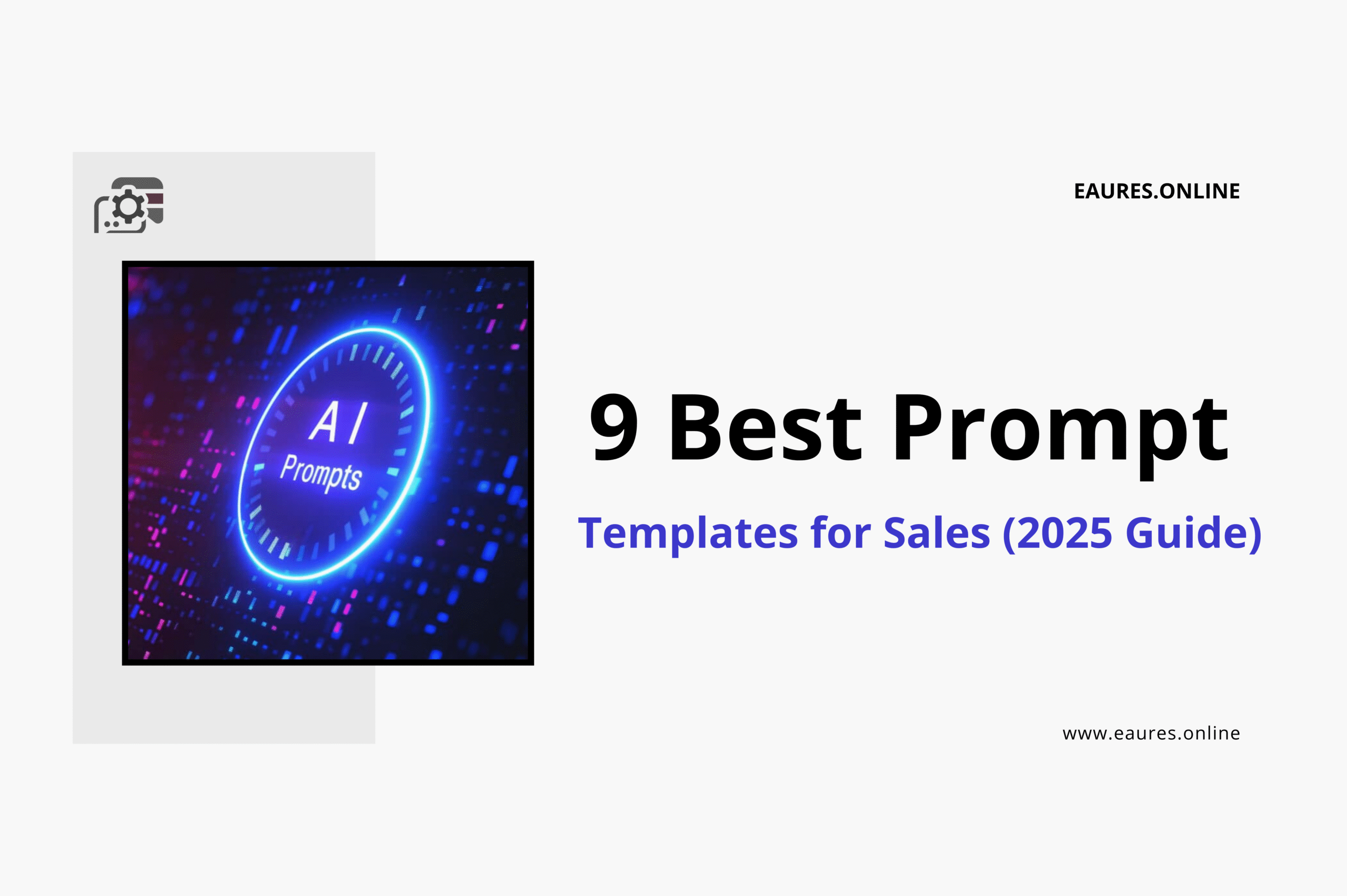Table of Contents
9 Best Prompt Templates for Sales 2025
Why the Best Prompt Templates for Sales Matter in 2025
Sales teams are operating in an era where every touchpoint can be personalized, tested, and improved in minutes. The Best Prompt Templates for Sales give your reps an “assist mode” that accelerates research, sharpens messaging, and standardizes process without suppressing creativity. When you design prompts as reusable building blocks—complete with variables, role instructions, constraints, and tone—you get consistent quality at scale while keeping space for human judgment.

In this guide, you’ll find nine field‑tested, high‑leverage templates mapped to the most critical stages of the revenue cycle. Each template shows when to use it, a ready‑to‑copy prompt, variables to personalize, and a quick example. Use these as a foundation and adapt them to your ICP, product, and motion. To maximize results, combine the Best Prompt Templates for Sales with a consistent prompting flow and lightweight governance so your team can iterate fast with confidence.
Tip: If your organization works across tools, see the unified prompting flow for Copilot and Claude to unify context, grounding, and iteration across daily tasks in one consistent method. For a hands-on framework, study the unified prompting flow for Copilot and Claude and mirror it in your sequences and coaching.
How to Use and Customize the Best Prompt Templates for Sales
Before you plug in the nine templates, align on a few shared standards so anyone on your team can get reliable output:
- Context first. Always provide job-to-be-done, target persona, use case, and stage of the deal.
- Ground the model. Feed 3–5 crisp facts: ICP traits, product capabilities, pricing guardrails, and key proof points.
- Set style and constraints. Define tone, length, format, and compliance rules for each message.
- Ask for structured output. Tables, bullets, or JSON make follow‑up actions easier in your CRM.
- Close with next steps. Every prompt should request “clear next actions” so outcomes don’t stall.
For productization, capture your Best Prompt Templates for Sales in a single source of truth your team already uses. Many teams keep their prompt libraries, sequences, and enablement assets in Notion because it pairs docs with AI. If you’re building this out, skim the curated Notion AI Templates for Teams to slot your prompt systems into project spaces, playbooks, and onboarding.
The 9 Best Prompt Templates for Sales
1) Prospecting & First‑Touch Email (Cold Outbound)
When to use
Top‑of‑funnel outreach where you need a tight, personalized hook aligned to one problem and one CTA.
Prompt Template
You are an SDR writing a concise first-touch email to a {persona} at {company} in {industry}.
Goal: earn a short reply confirming interest or gently disqualify.
Context about our product: {product one-liner}. Proof: {social proof}.
ICP pain to address: {pain}. Business outcome promised: {outcome}.
Constraints: 90–120 words, 6th–8th grade reading level, no hype adjectives, 1 link max, single ask.
Personalize with a sentence using {public signal} from {source} (post/news/job).
Tone: professional, curious, specific.
Output: subject (<=6 words), body (plain text), and 3 optional variants for A/B.
End with a clear yes/no CTA and calendar offer.
Variables{persona}, {company}, {industry}, {product one-liner}, {social proof}, {pain}, {outcome}, {public signal}, {source}
Example
Prospecting a VP Operations at a logistics firm? Pull a public signal like their recent network expansion and connect it to faster dock‑to‑dock time. Your Best Prompt Templates for Sales should nudge reps to keep a single, testable message and a frictionless CTA.
2) Discovery Call Planner (Question Map + Outcome Script)
When to use
Before a first or second discovery meeting to align on objectives, questions, traps to avoid, and closing outcomes.
Prompt Template
Act as a discovery coach for a {role} selling to a {persona} at a {company size}/{industry} company.
Deal stage: {stage}. Hypothesis of value: {value hypothesis}.
Frameworks to weave in: SPICED and MEDDICC (as checklists).
Create:
1) Agenda (3 bullets, timeboxed),
2) 10 discovery questions grouped by “Current State”, “Impact”, “Critical Events”, “Decision & Metrics”,
3) 5 red flags and how to probe them,
4) A 60-second summary script to align on next steps.
Style: consultative, concise, no jargon. Return as structured bullets.
Why it works
Good discovery questions organize a conversation around impact and decision dynamics. To deepen your practice, compare the structure of MEDDICC and SPICED using reputable outlines such as IBM’s explanation of BANT qualification and Winning by Design’s overview of SPICED. Embedding a consistent method inside the Best Prompt Templates for Sales keeps calls outcome‑focused.
3) Qualification & Call Summary (CRM‑Ready)
When to use
Immediately after a call to compress notes into the CRM with clear next actions and qualification status.
Prompt Template
Summarize this call transcript into a CRM-ready record.
Buyer persona: {persona}. Company: {company}. Stage: {stage}.
Map notes to MEDDICC fields (Metrics, Economic Buyer, Decision Criteria, Decision Process, Implicate Pain, Champion, Competition).
Include: 3 key pains, 3 business outcomes, 2 risks, identified stakeholders, timeline, budget signals.
Output JSON + readable bullets.
End with “Next Steps” (owner, due date, and concrete action).
Keep to factual statements pulled from transcript; avoid hallucinating.
Variables{persona}, {company}, {stage}, plus pasted transcript.
Why it works
The Best Prompt Templates for Sales save hours of admin and boost data quality when the output is opinion‑free, structured, and tied to fields you actually use.
4) Objection Handling Coach (Real‑Time & Asynchronous)
When to use
Before or after a conversation when you anticipate tough objections (pricing, change, security, switching cost).
Prompt Template
You are a sales coach preparing answers to the top 5 objections for {product} in {industry}.
Buyer persona: {persona}. Objection themes: {list of likely objections}.
Provide:
- Short response (2–3 sentences) with empathy + reframing,
- One question to advance the conversation,
- One proof point (case, metric, or quote).
Style: confident, calm, specific, no competitor-bashing.
Return as a 3-column table [Objection | Suggested Response | Advancing Question/Proof].
Advanced tip
Anchor responses to evidence. For example, reference a public case study or neutral source when possible. You can browse trusted analyses of account expansion or value narratives in Harvard Business Review’s coverage of generative AI’s impact on selling, such as the perspective in How Generative AI Is Changing Sales. Use links sparingly and always inside the conversation, not as footnotes.
5) Value Narrative & ROI One‑Pager (Proposal Precursor)
When to use
Before a formal proposal to align on business outcomes, proof, and the shape of value.
Prompt Template
Create a one-page value narrative for a {company size} {industry} buyer evaluating {product}.
Known pains: {pains}. Desired outcomes: {outcomes}. Constraints: {constraints}.
Include:
- Executive summary (4 sentences),
- Before/After workflow diagram (ASCII),
- 3 quantified value levers tied to buyer metrics (with assumptions stated),
- 2 relevant customer stories,
- A simple ROI model: inputs, formula, payback period in months,
- Risks & mitigations (3 bullets),
- CTA for a pilot with success criteria.
Tone: board-ready, no fluff. Return as clean sections and a final checklist of inputs to verify with the buyer.
Why it works
The Best Prompt Templates for Sales translate features into measurable business impact. If you’re new to structured value propositions, skim the widely referenced value proposition examples and frameworks and retrofit the language to your industry.
6) Follow‑Up & Nurture Sequence (Multi‑Touch)
When to use
After discovery or a demo when the account is interested but asynchronous motion is required to build consensus.
Prompt Template
Design a 5-touch follow-up sequence for a {persona} at {company} after a {demo/discovery/workshop}.
Goal: advance to {next milestone} within {timeframe}.
Inputs: {summary of meeting}, {objections}, {content assets available}.
Create 5 touches over {days}, mixing email/LinkedIn/phone.
For each touch: channel, message (<=120 words), asset to attach/link, and a clear CTA.
Tone: helpful and specific; avoid pressure language.
Add a micro-personalization hook for each based on {public signal}.
Where to deploy
If you run sequences from your CRM, weave these steps into your cadence tool. HubSpot’s documentation on creating sequences is a good reference to translate the prompt output directly into automation.
7) Upsell & Cross‑Sell Trigger Play (Customer Success + AM)
When to use
In post‑sale accounts when usage signals or lifecycle events suggest expansion potential.
Prompt Template
Act as an Account Manager designing an upsell/cross-sell play for an existing customer.
Context: {customer name}, current products: {licenses/modules}, usage data: {signals}, upcoming events: {renewal/launch/hiring}.
Generate:
- Hypothesized needs based on signals (3 bullets),
- 2 expansion offers (problem-led, not feature-led),
- Executive email (<=100 words) and user-level email (<=100 words),
- 3 slides outline for a 20-min check-in,
- Success criteria and risk checklist.
Tone: consultative and respectful; prioritize customer outcomes over revenue.
Why it works
The Best Prompt Templates for Sales for expansion require a balance of timing and relevance; the language must sound like a partner, not a quota push.
8) Proposal & SOW Draft (With Redlines Checklist)
When to use
When a deal is headed to close and a first structured document is required for Legal and Procurement.
Prompt Template
Draft a concise proposal + SOW for {product} at {company}.
Scope: {modules}, timeline: {dates}, delivery model: {model}, price guardrails: {range}.
Include sections: Objectives, Scope, Deliverables, Assumptions, Timeline, Responsibilities, Acceptance Criteria, Pricing (with options), and Out-of-Scope.
Add a redlines checklist for legal/procurement covering data processing, term, termination, SLAs, support tiers, and security.
Style: plain English, no marketing claims. Flag any placeholders clearly with [NEED INPUT].
Deepening the craft
If your org lives in Salesforce, explore how Prompt Builder or Einstein workflows can host your SOW scaffolds inside CRM processes; Salesforce’s public pages on Einstein and Prompt Builder outline how to embed templates into flows rather than copy/paste between tools.
9) Demo Script & Competitive Angle (Sales + SE)
When to use
For product demos where your story must align to persona and competitive context without turning into feature tours.
Prompt Template
Create a 12-minute demo script for {product} tailored to a {persona} at a {industry} company.
Inputs: {key pains}, {desired outcomes}, {competitors}, {differentiators}, {security/compliance needs}.
Deliver:
- 3-scene narrative (Problem, New Way, Proof),
- Talk track bullets with timeboxes,
- Live data inputs to prepare,
- 3 competitor-specific traps to avoid and positioning pivots,
- Closing summary in <60 seconds with next step ask.
Tone: confident, customer-first, zero jargon.
Why it works
Demo clarity rises when your talk track mirrors the buyer’s mental model of “old way vs. new way.” If sales engineers also write scripts or small tools, compare modern assistants in this year’s roundup of the best AI code assistants in 2025 to accelerate preparation without sacrificing accuracy.
Implementation: Operationalizing the Best Prompt Templates for Sales
To embed the Best Prompt Templates for Sales into your day‑to‑day:
1) Create a shared library with versioning.
Host a single, documented library of prompts with examples, do’s/don’ts, and inputs. A lightweight page per template prevents drift and encourages feedback. If your team is standardizing on Notion and cares about security and adoption, review the latest Notion AI review for 2025 to understand Q&A vs Enterprise Search, Autofill, and meeting notes for sales workflows.
2) Standardize your prompt skeleton.
Adopt a house style with sections like Role → Context → Constraints → Output → Next Steps. This aligns with the OpenAI prompt engineering guide and keeps prompts readable and testable.
3) Wire prompts into the tools reps already live in.
Keep your Best Prompt Templates for Sales accessible from CRM buttons, email sidebars, or help center articles. Google’s Vertex AI design notes on prompt design can inspire guardrails when you operationalize across systems.
4) Add guardrails and compliance notes per template.
Attach rules for claims, regulated industries, and privacy. For outbound, align with the FTC’s CAN-SPAM compliance guide. If you sell into the EU, keep data handling basics consistent with GDPR requirements.
5) Build a two‑way feedback loop.
Add a quick checklist: Did the template help? What did you change? What response did you get? Reps rate usefulness; enablement owners fold the best edits back into the source.

Optimization: Testing the Best Prompt Templates for Sales
Treat prompts like high‑impact copy. Small changes can deliver outsized gains.
A/B and Multivariate Ideas
- Subject lines: Test length (3–6 words vs. 7–10), specificity (pain vs. outcome), and curiosity.
- First lines: Personalization (public signal vs. industry stat) often swings reply rates.
- CTA clarity: “Worth a quick 12‑minute chat?” vs. “Would it be helpful to…”.
- Length: Try 90–120 words vs. 150–180 depending on persona seniority.
- Format: Paragraphs vs. bullets, especially for technical buyers.
Metrics to track per template
- Prospecting: delivered, open, reply, positive reply, meeting rate.
- Discovery: show rate, multithread rate, new stakeholder adds.
- Qualification: time‑to‑next step, field completeness, forecast accuracy.
- Proposal: time‑to‑legal, redline cycles, win rate.
- Expansion: product adoption uplift, cross‑sell attach rate.
Wrap these into dashboards and weekly reviews. The Best Prompt Templates for Sales improve fastest when measured with the same rigor you apply to pipeline creation and conversion.
Voice, Tone, and Compliance Patterns Inside the Best Prompt Templates for Sales
Tone ladders
Publish two or three “tone ladders” your reps can cite in prompts: Board‑ready, Consultative, Technical candid, Friendly direct. Your templates should specify one and ban the rest to avoid tonal drift.
Plain‑language guidelines
Ban “supercharge, revolutionary, cutting‑edge.” Replace with concrete benefits and numbers. Great Best Prompt Templates for Sales sound calm, specific, and outcome‑based.
Claims & proof
Require a proof object for every claim: case study URL, quote, or number. Link sparingly in the body (never as a footnote). This is both persuasive and safe.
Privacy & data handling
Never paste PII into external tools without a clear policy. Your outbound prompts should nudge reps to use only public signals (press, LinkedIn posts, job listings) and your own CRM data. For an internal refresher for legal and enablement, keep a quick link to the FTC’s business guidance hub and your internal policy.
Advanced: RAG and Sales Knowledge Layers
A repeatable way to level‑up the Best Prompt Templates for Sales is adding retrieval‑augmented generation (RAG):
- Documents to index: case studies, security FAQs, pricing guardrails, competitive notes, and implementation guides.
- Chunking strategy: store 200–400‑word chunks with metadata (industry, product, region).
- Prompt pattern: “Use only the passages below; if uncertain, say you’re unsure. Cite section titles in‑line.”
- Quality gates: reject outputs with claims not supported by retrieved passages.
This puts current, accurate facts behind your templates and reduces back‑and‑forth with legal and solutions teams.
Quick Reference: Copy‑Ready Versions of the 9 Best Prompt Templates for Sales
1) Prospecting & First Touch (copy block)
ROLE: SDR emailing {persona} at {company} in {industry}
CONTEXT: {product}, proof {social proof}, pain {pain}, outcome {outcome}, public signal {signal} from {source}
CONSTRAINTS: 90–120 words, 1 link, single CTA, plain style
OUTPUT: subject (<=6 words) + email + 3 variants; end with simple yes/no ask
2) Discovery Planner
ROLE: Discovery coach for {role} selling to {persona}
CONTEXT: Stage {stage}, value hypothesis {value}
INCLUDE: Agenda, 10 grouped questions, 5 red flags, 60-sec alignment script; weave SPICED + MEDDICC
3) Qualification Summary (CRM)
ROLE: CRM summarizer
INPUT: Transcript
OUTPUT: MEDDICC fields, 3 pains, 3 outcomes, 2 risks, stakeholders, timeline & budget signals, JSON + bullets, Next Steps with owner/date
4) Objection Coach
ROLE: Sales coach
INPUT: Top objections for {product}/{industry}/{persona}
OUTPUT: Table [Objection | Response | Advancing Q/Proof]; empathetic, specific, no bashing
5) Value Narrative & ROI
ROLE: Value consultant
INCLUDE: Exec summary, ASCII before/after, 3 value levers with assumptions, 2 stories, simple ROI with payback, risks & mitigations, pilot CTA
6) Follow‑Up Sequence
ROLE: Sequence designer
CONTEXT: Post {demo/discovery}; goal {milestone}; days {N}
OUTPUT: 5 touches with channel, message, asset, CTA; micro-personalize with {signal}
7) Upsell/Cross‑Sell Play
ROLE: Account Manager
INPUT: {licenses}, {usage signals}, {renewal date}
OUTPUT: Needs hypotheses, 2 expansion offers, exec & user emails, 3-slide outline, success criteria & risks
8) Proposal & SOW Draft
ROLE: Proposal writer
INPUT: Scope {modules}, timeline {dates}, model {delivery}, price {range}
OUTPUT: Proposal sections + redlines checklist; plain English, placeholders flagged
9) Demo Script & Competitive Angle
ROLE: Presenter/SE
INPUTS: {pains}, {outcomes}, {competitors}, {diffs}, {security}
OUTPUT: 3-scene narrative with timeboxes, talk track, live data prep, competitive traps & pivots, 60-sec close

Coaching Managers: Rolling Out the Best Prompt Templates for Sales
Kickoff workshop (60–90 minutes)
- Walk through the nine templates with one live account.
- Co‑edit the prospecting and discovery templates as a team to set the house style.
- Assign owners per template and decide review cadence.
Shadowing and call reviews
- Add a prompt QA step to call reviews: “Which template? What changed? What result?”
- Capture “winning lines” and fold them back.
Playbook upkeep
- Version prompts monthly. Use clear changelogs.
- Archive variants that underperform; keep a “graveyard” to avoid repeating mistakes.

FAQs About the Best Prompt Templates for Sales
1) How many of the Best Prompt Templates for Sales should a team use at once?
Start with three: Prospecting, Discovery Planner, and Qualification Summary. As adoption grows, add Follow‑Up, Objection Coach, and Value Narrative. Eventually bake in Proposal, Upsell, and Demo Script.
2) Can we personalize at scale without sounding robotic?
Yes—your Best Prompt Templates for Sales should include a genuine public signal (post, news, job) that connects to a specific pain. Fine‑tune tone and length by persona and seniority.
3) Where should these templates live?
Keep them where reps work: CRM quick actions, email sidebars, and your enablement space. Many teams manage prompt libraries alongside workflows using Notion; see the curated Notion AI Templates for Teams for examples.
4) How do we keep claims accurate and compliant?
Attach a simple proof requirement to each template. Link to public sources or internal docs. For outbound, keep messaging aligned to the FTC’s CAN-SPAM rules and your internal data policy.
5) What’s the fastest way to improve results?
Instrument response rates and positive replies per template, then run weekly micro‑tests. Rotate one variable at a time (subject, first line, CTA). Your Best Prompt Templates for Sales will compound in effectiveness with persistent tuning.
Conclusion: Make 2025 the Year Your Templates Do the Heavy Lifting
The Best Prompt Templates for Sales don’t replace your team’s instincts—they multiply them. Start with the nine templates here, standardize a skeleton, wire them into your daily tools, and measure relentlessly. As you scale, unify your flow across AI assistants so every rep can plan discovery, write compelling emails, craft value narratives, and progress deals with less friction and more confidence. With a shared library, clear guardrails, and a culture of iteration, your prompts become an enduring sales asset.




